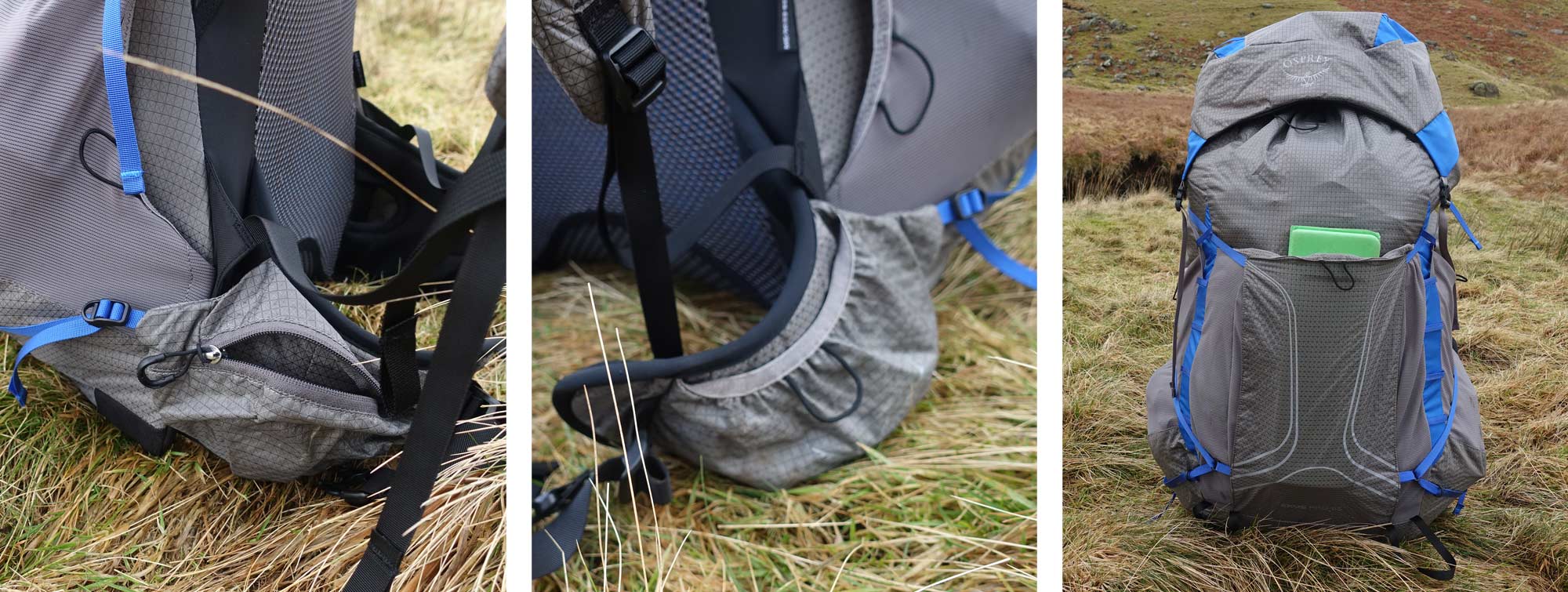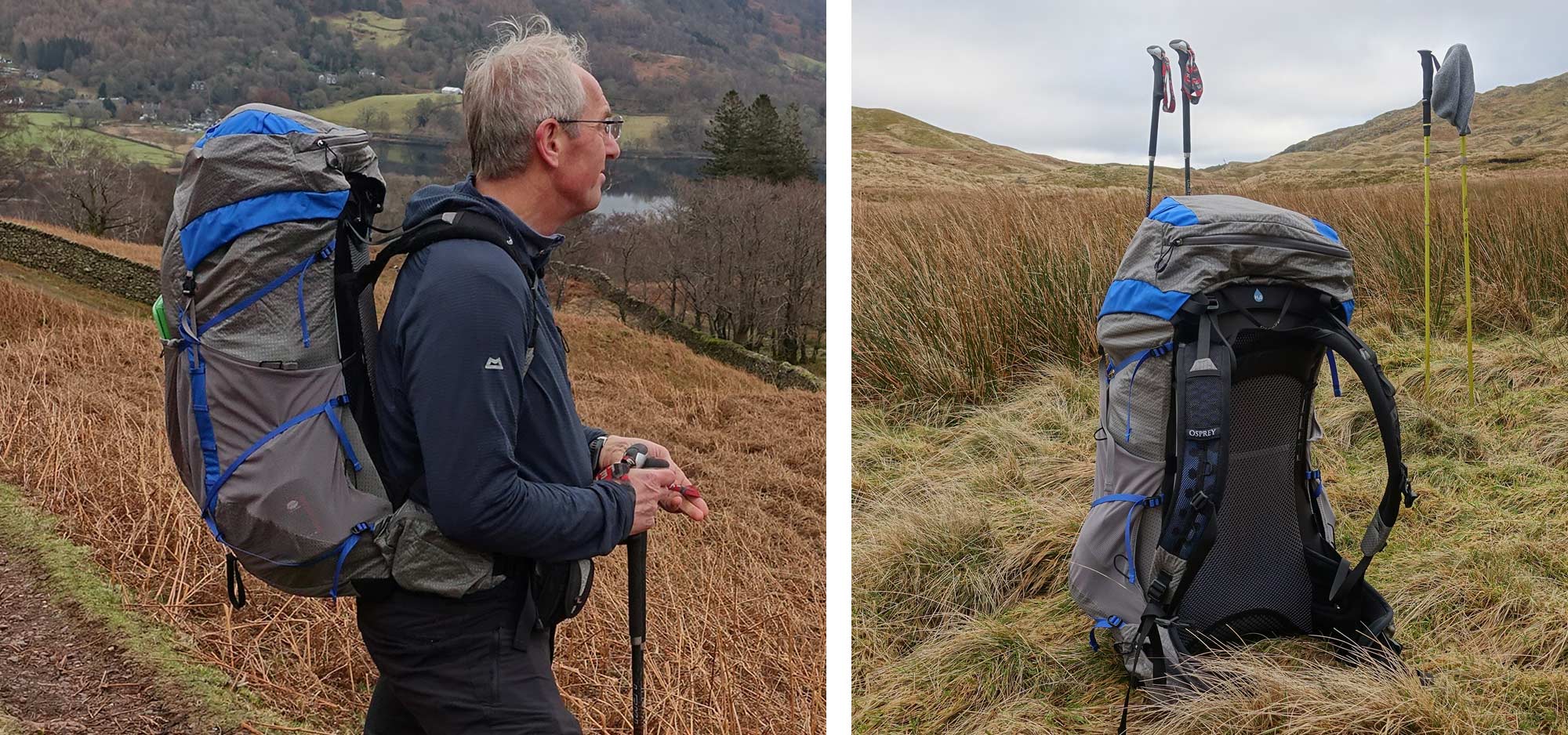Osprey Exos Pro 55 Review - “I was impressed by the capacity of the pack!”
Posted by Mark Richardson on Feb 23, 2023

Osprey’s Exos packs are best sellers; and for backpacking loads over say 15kg they are a good choice, offering a comfortable carry at a low weight. Typically weighing in at 1.3Kg there are lighter options for ultralight backpackers where the target weight is around a kilogram for a fully spec’d backpacking rucksack of between 50 and 60 litres capacity.
A few years ago Osprey produced the Levity (and Women’s version, the Lumina), which was a very accomplished ultralight pack that was firmly below the 1kilogram threshold and we loved it.
For 2023 Osprey have released the Exos Pro 55 (and Women’s version the Eja Pro 55), which is very much a combination of the earlier Levity and best-selling Exos series and still weighs less than that kilogram target. We took it for a test drive earlier this month.
First Impressions
The most important part of a backpacking rucksack is the harness and the Exos Pro 55 looks good in this respect, the hip belt has large supportive padded fins, both with pockets (one zipped and the other elasticated), and the shoulder straps are well padded for this class of rucksack and the whole thing is supported by a wire frame. A mesh back panel is stretched over the frame creating an air gap between the wearer and the pack.
The back length can be adjusted using a simple toggle system which is very easy to use.
The top closure is worth noting here, the pack comes with a conventional lid with a large-ish zipped top pocket, but this can be removed, reducing the pack weight by81 grams. With this lid removed there’s still an integral flap to cover the top of the pack to protect the drawcord closure from rainwater.
Sizing and Fit
The Exos Pro 55 comes in two sizes, Small/Medium and Large/Xlarge corresponding to back lengths 43-50.5cm and 48-58.5cm. I’m 5ft 11inches with a back length of 53cm, and therefore my preferred size is Large/Xlarge, having looked at both we think the larger size pack also has a larger volume so if you are in two minds about which one to get this might help you decide.
In truth, if you are between the two sizes, either one will fit you fine.
Features
Hip belt pockets
These are quite large and easy to use, being bellowed they can still be used when the hipbelt is fastened tightly.
Volume Compression
I’m not a fan of compression straps but most rucksacks have them and the Exos Pro 55 is no exception. They pull in the sides and are quite effective, they are also linked to the hip belt pockets which seems odd to me. Also, the strap passes over the side mesh pockets making them difficult to use with the compression strap tight.
Side Mesh Pockets
These are large and are easily accessible while wearing the pack because they open at the front edge as well as the top. They have a fabric lower section which is the vulnerable point in terms of their durability which is great, it means you can put poles in there without worrying about puncturing the mesh.
Main Body Front Pocket
This is large and mainly fabric, stretch mesh is used at the sides. Traditionally used for wet gear this pocket fulfils its purpose admirably.

Removable Lid Pocket
The top pocket is a good size, and at 80 grams I would usually leave it attached because I like the extra organisation it gives me – but that’s a totally personal preference.
Flap
Without the top pocket/lid the flap works well at keeping out the worst of the weather.
Hydration
There’s an internal bladder pocket for those that use them and a clip for use with Osprey Hydration bladders but will also fit others so long as there’s a slot at the top.
Attachment Points
There are loops for ice axes or perhaps could be adapted for trekking poles but more importantly there are two webbing ladders up the front of the pack which can be used to attach a range of gear, I particularly like these as I could see me fastening a solar panel to it on sunny days using some micro karabiners. I also use these things to hang towel, clothes etc to dry out while I’m trekking. There are four loops on the pocket/lid as well which can be used in a similar way.
Base
The base of the pack has a double layer of fabric for durability.
In Use
I tried the Exos Pro out on a backpacking trip to the Lakes in February and liked it a lot, I was carrying about 24lbs (11Kg) so it wasn’t over-worked but I certainly felt it could handle more. It was comfortable and the hip belt gripped my hips well though the shoulder straps took slightly more weight than I’m used to, having said that the back panel is designed to sit slightly off the back and with a relatively low weight I took advantage of this, if I was carrying closer to 30lbs (14Kg) I’d cinch the shoulder strap adjustments to bring it closer to my centre of gravity, this would also reduce the pressure on the shoulders.
I was impressed by the capacity of the pack! Often you look at the quoted capacity of a pack and think ‘really?’ but the Exos Pro felt its full 55 litres just in the main compartment, it swallowed my winter kit and there was room left over for additional food should I have needed it.
Everything works well, the side mesh pockets are accessible when on the move due to the forward facing openings and yet there seems little chance of anything falling out. I had a little niggle with the zipped pocket on the hip belt, when fully open it wouldn’t just pull closed, I had to use two hands to get the slider moving.
I felt the floating lid could have been fastened lower on the frame side or perhaps a third fastening point in the middle would help it sit over the top of the pack better, but all these points are niggles, it’s a really accomplished backpacking rucksack at a very low weight.


|
||
 |
||
|
Mark Richardson |
||
|
Mark was the founder of Ultralight Outdoor Gear back in 2006 and has completed long distance backpacking routes in some of the remotest parts of the world. His favourite hikes have been Torres del Paine (full circuit), the John Muir trail and the Markha Valley trail (Ladakh, India). Although semi-retired Mark has not lost any enthusiasm for minimalist backpacking and is tackling Scotland’s Munros choosing multi-day backpacking routes over the more usual guide book excursions. |
||
